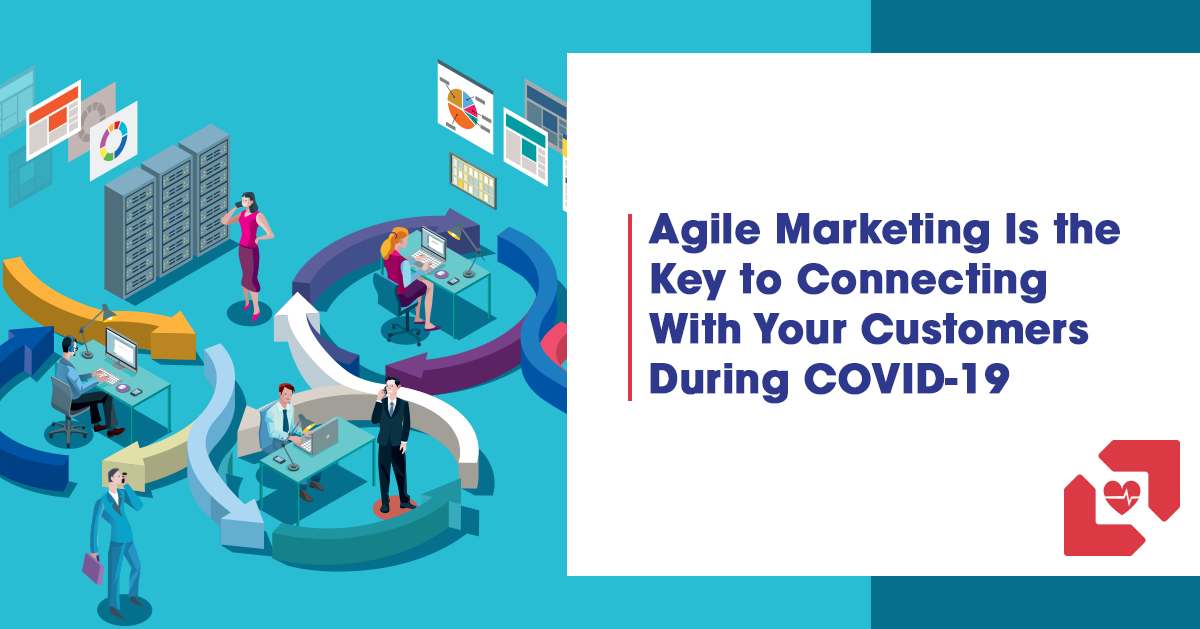Companies that embrace agile marketing now will set themselves up for recovery and success in the future.
It’s no longer a question whether this global crisis will fundamentally alter how we live. It’s a matter of “how” and “when.” The new digital world is customer-centric, more so now than ever. While traditional marketing puts production and sales cycles at the core of how it operates, agile marketing puts customers and their buying processes first. In this new environment, companies take on a different role with consumer trust at its heart. As brands prepare to meet these evolved digital demands, agile marketing is what will get them across the finish line first. This is what customers not only want but demand – solutions that are not only impactful but fast.
98% of companies already report that their organizations have seen success from agile projects, with top benefits including accelerated delivery, better project visibility, improved team productivity, and stronger management of changing priorities. These are precisely the type of improvements that help address the shifting consumer behaviours during COVID-19 head-on. The companies that work now to either up their existing agile marketing strategy, or implement aspects of it into their current less-agile processes, will be prepared to meet customer needs both during the crisis and into the next normal.
Consumers are already rewarding (or punishing) brands based on how they’re behaving
Globally, 37% of consumers reported that they’ve already started using a new brand that showed innovation and compassion in response to the outbreak. 71% of global consumers right now say a company would “lose their trust forever” if they perceive it as putting profits before people during the crisis. At the same time, 1 in 3 said they’ve already ditched a brand because they felt they weren’t behaving appropriately.
This isn’t a slow burn, and you don’t have time to wait around and see what happens before you choose a direction. The impact of COVID-19 on how society operates was swift, and customers are acting just as swiftly to decide which brands will earn their loyalty. There’s no time to wait to adapt to their heightened needs and current expectations.
Use COVID-19 as a catalyst for change
One of the biggest hurdles to adopting agile marketing practices is usually complacency. During more predictable times, inertia and an “if it ain’t broke” mentality make it more difficult to get buy-in across your business. Now, all bets are off. A black swan event (like a global pandemic) forces not only an immediate urgency for change but also reduces people’s regular intolerance to risk. Everything right now is risky, so leaders are more open to new ideas to help their organizations weather the storm.
Allison Humphries, VP of Strategy at Appnovation states, “Digital-first organizations are naturally more prepared for change. For those that aren’t, this is an ideal time to become more agile. Both externally and internally, people aren’t only expecting things to get shaken up, many are insisting on it. Everyone will be clamouring to prove their ability to adapt and innovate. The companies that can make it happen quickly, show how they’re helping. And the brands that do it with empathy and awareness are the ones customers will fall in love with. What we do today is fundamental for how customers will think of us tomorrow.”
This is the perfect time to confront misinformed attitudes about what “agile” really means. It’s not only about speed to respond. Agile marketing helps to create flatter organizations with lean practices that increase value for the end-users while reducing costs for the business.
Humphries continues,“Agile is about a way of thinking – first and foremost. It puts humans at the centre of your work practices and gives them the organization and infrastructure they need to bring good ideas to life in shorter time frames. It’s the mindset to believe wholeheartedly in this ethos, and support it with action, that leads to the benefits. You can’t just ‘be agile’ without believing in agility.”
Adjust your mix… before it adjusts for you
Waiting for the world to go back to a notion of ‘normal’ is a recipe for failure. From supply chains to demand projections to delivery processes, every aspect of doing business right now has been thoroughly disrupted. The same thing applies to your marketing mix, and agility is how you can address it quickly and re-balance effectively. (And then do the same thing tomorrow, next week, and the week after that.) Iterative work cycles are a fundamental part of agile working, and they’ve never been more important than right now as information and attitudes switch daily. Whether you already had a contingency plan and were agile enough to move to it, or are just preparing now, it’s those who can move not only quickly but meaningfully who will win. Everyone is rushed, nobody feels comfortable, and so relying on strategies and structures that prioritize your comfort will guarantee that you don’t succeed.
Don’t let perfection be the enemy of the good. Empathy, honesty and demonstrating a desire to help the common good are more important right now than a fully-laid out strategy:
- Turn to the fundamentals of data and analytics to measure how you’re doing and learn your customers’ evolving behaviour.
- Review your own customer and user experiences to see where you can improve, finesse language, and remove friction from your digital touchpoints.
The world is online, whether by isolation or choice and now is the perfect time to double down on content. The key here is to make sure it’s impactful, thoughtful and relevant to the mood of the times. That doesn’t mean you have to create net new. Take some time for you and your team to consider these questions:
- What elements of your event strategy or brick and mortar experience can you adapt to come to life online?
- What video content and podcasts do you have in your digital library that you can swiftly re-purpose and make it more useful during the crisis?
- How can you take your traditional out-of-home marketing strategy and reinvent it for social, email and other stages of your CRM flow?
- How can you empower your employees and give them a voice to become advocates for your brand?
Plan for anything and everything
COVID-19 has taught us that anything can happen, and it won’t always be the things we think we’re prepared for. Reviewing or establishing your operational model is crucial in identifying what measures you have in place and how it’s currently functioning. You can then look at what you should abandon or ramp up based on the speed and quality of your responses to the outbreak.
On the scale of essential services, evaluate where you rank right now and think about how you can do business within these new parameters.
- What do you offer that can be scaled up or down to make your current services logistically available during a lockdown? Is it a valuable service or product? Take out, home delivery, curbside pickup, increased shipping options, independent brick and mortar stores selling one-to-one via social channels, and inventive cross-partnerships are current agile examples of how businesses can get their product to people during isolation.
- What are you capable of doing that you could pivot toward to support essential workers, at-risk populations or society as a whole? Think of distillers changing production to make hand sanitizers, clothing retailers switching production to masks and other PPE, and large-scale manufacturers moving to produce ventilators and other necessary medical equipment.
If you can’t find a way to meaningfully pivot what you do, then find a way to help people contribute or donate to worthwhile charities through your business. The last thing you want to do is to shoehorn your brand offering into areas that don’t make sense just to be part of the conversation. Lack of relevancy will hurt you in the long run. Any company can help facilitate contributions from sales, volunteerism from employees, and donations of what they do to help frontline workers. Hotels offering free rooms to medical staff between shifts and car manufacturers donating vehicles to food banks and delivery services for vulnerable groups are shining examples of this kind of approach.
Agile and remote work go hand-in-hand
Early on, agile teams were specifically designed to work in close physical proximity to encourage face-to-face collaboration and easy interaction. The bad news: while that’s still a viable way of working, in theory, most of us are in isolation and tackling tasks side-by-side is out of the question. The good news: the fundamentals of agile are natural fits for any kind of remote team, whether permanent or temporary due to COVID-19.
Distributed teams are inherently suited to thinking outside of the box. Asynchronous working, digital platforms enabling regular steps of the agile framework, and independence encourage new ways of working remotely that will also help employees keep up with the demands of their home and family life. With many professionals regularly working from home for the first time, this is a prime opportunity to inspire an agility mindset while regular processes are already switched up.
The power of agile marketing doesn’t come from being in the same room, it comes from a shared mindset and commitment to reaching shared goals. Planning, aligning and regular cycles of test-measure-improve are core strategies built into agile thinking. Teams that are adopting this approach and collaborating – even when they’re apart – are one step closer to helping their business find new directions to address the pandemic.


